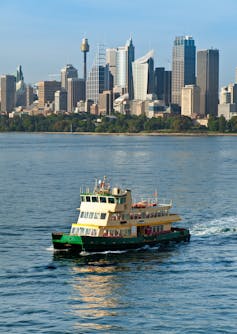Here’s why some people still evade public transport fares – even when they’re 50 cents
- Written by Milad Haghani, Associate Professor & Principal Fellow in Urban Risk & Resilience, The University of Melbourne

Public transport in Queensland now costs[1] just 50 cents. Yet in the first six months of the trial, it’s been revealed that thousands of commuters were fined for fare evasion[2].
More than 3,000 people received fines of A$322 each, amounting to more than $1 million in penalties. And more than 21,000 were issued warnings over this period.
Queensland’s 50 cent fares trial was designed to boost ridership and ease cost-of-living pressures. Now it has exposed a paradox: why do people evade fares even when the price is nearly free?
Fare evasion isn’t just a Queensland problem — it’s a nationwide challenge. Queensland’s experience raises bigger questions about enforcement, policy, and the role of public transport funding.
A nationwide challenge
Across the country, fare evasion drains millions from state public transport budgets. In New South Wales, for example, fare evasion costs the state government about $80 million each year[3].
The latest NSW Fare Compliance Survey[4] inspected 52,152 tickets, including Opal cards, contactless payments, and single-trip tickets, across the NSW public transport network.
It found most non-compliance came down to passengers travelling without a valid ticket. This included not only those customers carrying no ticket at all, but also those who did have an Opal or other payment card but hadn’t tapped on.
Another form of non-compliance was when passengers used concessions for which they weren’t eligible.
The survey also highlighted variations in compliance – across different modes of transport, times of day and days of the week.
Overall, compliance did not significantly differ between weekends and weekdays.
Looking at weekday use, Sydney Metro had the highest compliance rate at 97%. This was followed by Sydney Ferries (95.9%), all trains (93.6%), Sydney Light Rail (91%) and all buses (89.2%).
Who evades fares and why?
Fare evasion isn’t just about people trying to save money. Research shows there are different types of fare evaders, ranging from habitual dodgers to those who evade unintentionally.
An international study[6] on Santiago’s Transantiago system found that evaders could be categorised into four groups:
- radical evaders who view non-payment as a form of protest
- strategic evaders who evade when they believe the risk of being caught is low
- ambivalent evaders who sometimes pay but don’t always see the value in it
- accidental evaders who forget or run into ticketing system barriers.
A separate study in Melbourne also identified a wide spectrum of attitudes[7] on fare evasion, from those who consider it morally wrong to those who take calculated risks based on enforcement patterns.
Does lowering fares reduce evasion?
Queensland’s 50-cent fare trial presents a real-world test of a long-standing question: does cheaper public transport reduce fare evasion?
Our calculations using the state’s early data[9] show a 27% drop in fare evasion fines since the trial began, compared with the same period in the previous year.
This aligns with the idea that fare evasion is, at least partially, a rational economic decision. When the price is lower, the incentive to evade diminishes – though it does not completely disappear.
Modelling evidence[10] from Santiago’s bus system also suggests price sensitivity, but with caveats. A 10% increase in fares led to a two-percentage-point rise in fare evasion.
The role of trust and public perception
A surprising insight from research is that fare evasion isn’t just an economic decision. It’s a social[12] one, too.
When passengers perceive the system as unfair (due to factors such as unreliable service, high fares or lack of investment), fare evasion rises[13].
Further, if fare dodging behaviour is normalised within a city or demographic, it spreads like contagion[14].
Studies have suggested that permissive social attitudes[15] toward fare evasion are as strong a predictor as actual financial hardship.
The limits of enforcement
Most transit agencies rely on two standard deterrents: more ticket inspections, and harsher fines for fare evaders.
Does this approach work? Research suggests only to a point.
Empirical evidence suggests that potential evaders are more deterred by the certainty of getting caught[17] than by the size of the fine.
In other words, the visibility of inspectors matters more than the penalty itself. For many, the social stigma[18] of getting caught is a key factor, regardless of how big the penalty is.
A crucial question in the Queensland debate is: if public transport is already nearly free, does fare evasion even matter?
The lost revenue from the unpaid fares by those who were issued a fine over the period in question amounts to just $1,663[19].
Depending on the level of crackdown, at such low fees, enforcement measures could easily end up costing more than the revenue lost. Security patrols, inspections and fine processing can amount to significant costs[20].
Why it matters
There are at least two key factors to consider in relation to whether cracking down on evaders is worth it.
First, allowing widespread fare evasion could erode social norms around paying for public services. If the expectation of compliance disappears, what happens if fares rise again?
And second, even when fares are zero or near-zero, requiring passengers to validate a ticket (such as by tapping on and off) allows transport agencies to track demand, plan services, and prevent system abuse.
Even in Tallinn, Estonia[21] — where residents ride for free — tap-ons are still required for data collection and preventing system abuse.
Even at 50 cents a trip, authorities still expect public transport to function within a structured system, with rules that encourage accountability and predictability.
But enforcement alone won’t solve fare evasion. Winning public trust is just as important as enforcing rules. Investing in better service quality, reliability and community engagement can be as effective as increasing inspections.
References
- ^ costs (statements.qld.gov.au)
- ^ fined for fare evasion (www.abc.net.au)
- ^ $80 million each year (transportnsw.info)
- ^ NSW Fare Compliance Survey (www.transport.nsw.gov.au)
- ^ Gordon Bell/Shutterstock (www.shutterstock.com)
- ^ study (www.mdpi.com)
- ^ wide spectrum of attitudes (www.sciencedirect.com)
- ^ Con Chronis/AAP (photos.aap.com.au)
- ^ data (www.abc.net.au)
- ^ Modelling evidence (www.sciencedirect.com)
- ^ Bianca De Marchi/AAP (photos.aap.com.au)
- ^ social (www.tandfonline.com)
- ^ fare evasion rises (www.sciencedirect.com)
- ^ like contagion (www.sciencedirect.com)
- ^ permissive social attitudes (www.sciencedirect.com)
- ^ Adam Calaitzis/Shutterstock (www.shutterstock.com)
- ^ the certainty of getting caught (www.sciencedirect.com)
- ^ the social stigma (www.scielo.br)
- ^ $1,663 (www.abc.net.au)
- ^ amount to significant costs (www.sciencedirect.com)
- ^ Tallinn, Estonia (ruralsharedmobility.eu)
Authors: Milad Haghani, Associate Professor & Principal Fellow in Urban Risk & Resilience, The University of Melbourne







